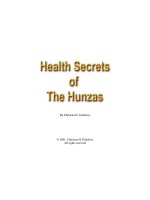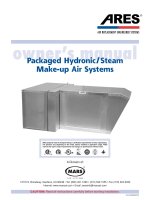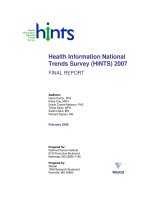Tài liệu Health Effects of Particulate Matter Air Pollution pptx
Bạn đang xem bản rút gọn của tài liệu. Xem và tải ngay bản đầy đủ của tài liệu tại đây (5.51 MB, 73 trang )
Health Effects of Particulate
Matter Air Pollution
C. Arden Pope III
Mary Lou Fulton Professor of Economics
Presented at
EPA Wood Smoke Health Effects Webinar
July 28, 2011
What we breath impacts our health
Pure Air nitrogen (78%),Oxygen (21%), Argon, CO
2
. . .
+
Various gaseous pollutants including:
– SO
2
, NO
2
, CO, O
3
. . .
+
Particulate matter:
– Course particles (> 2.5 mm in diameter)
– Fine particles (< 2.5 mm in diameter)
+
Other air toxics
Wood
Smoke
Introduction to Particulate Matter
(PM)
EPA PM Criteria Document, 2004 EPA PM Criteria Document, 2004
How small are fine particles?
Human Hair
(60 mm diameter)
PM
10
(10 mm)
PM
2.5
(2.5 mm)
Magnified ambient particles (www.nasa.gov/vision/earth/environment)
chronologically, but methodologically
Studies of short-term exposure (hours-days)
Episode
Population-based daily time-series
Panel-based acute exposure
Case-crossover
Studies of long-term exposure (years-decades)
Population-based cross-sectional
Cohort-based mortality
Cohort- and panel-based morbidity
Case-control studies
Intervention/natural experiment (months-years)
Controlled experimental human and animal
This presentation not organized
chronologically, but methodologically
Studies of short-term exposure (hours-days)
Episode
Population-based daily time-series
Panel-based acute exposure
Case-crossover
Studies of long-term exposure (years-decades)
Population-based cross-sectional
Cohort-based mortality
Cohort- and panel-based morbidity
Case-control studies
Intervention/natural experiment (months-years)
Controlled experimental human and animal
Q
&
A
This presentation not organized
chronologically, but methodologically
Studies of short-term exposure (hours-days)
Episode
Population-based daily time-series
Panel-based acute exposure
Case-crossover
Studies of long-term exposure (years-decades)
Population-based cross-sectional
Cohort-based mortality
Cohort- and panel-based morbidity
Case-control studies
Intervention/natural experiment (months-years)
Controlled experimental human and animal
Early “Killer smog” episodes demonstrated that air pollution at extreme
levels can contribute to respiratory and cardiovascular disease and death
Dec. 5-9, 1952: London 1000’s of excess deaths
Dec. 1-5, 1930: Meuse Valley, Belgium
60 deaths (10x expected)
Oct. 27-31, 1948: Donora, PA
20 deaths, ½ the town’s population fell ill
Respiratory and cardiovascular
disease and death
London Fog Episode, Dec. 1952
From: Brimblecombe P. The Big Smoke, Methuen 1987
Utah Valley, 1980s
• Winter inversions trap local pollution
• Natural test chamber
• Local Steel mill contributed ~50% PM
2.5
• Shut down July 1986-August 1987
• Natural Experiment
Large difference in air quality
when inversions trap air pollution in valley
Utah Valley: Clean day
Utah Valley: Dirty day
(PM
10
= 220 mg/m
3
)
m
g/m
3
/Numbers of Admissions
0
50
100
150
200
250
300
PM
10
concentrations
Children's respiratory hospital admissions
Mean PM
10
levels for
Months
Included
Mean High
PM
10
levels for
Months
Included
Pneumonia
and
Pleurisy
Bronchitis
and
Asthma
Total
Children's Respiratory Hospital Admissions
Fall and Winter Months, Utah Valley
Sources: Pope. Am J Pub Health.1989; Pope. Arch Environ Health. 1991
When the steel mill was open, total children’s hospital
admissions for respiratory conditions approx. doubled.
m
g/m
3
/Numbers of Admissions
0
50
100
150
200
250
300
PM
10
concentrations
Children's respiratory hospital admissions
Mean PM
10
levels for
Months
Included
Mean High
PM
10
levels for
Months
Included
Pneumonia
and
Pleurisy
Bronchitis
and
Asthma
Total
Children's Respiratory Hospital Admissions
Fall and Winter Months, Utah Valley
Sources: Pope. Am J Pub Health.1989; Pope. Arch Environ Health. 1991
Mill
Open
Mill
Closed
This presentation not organized
chronologically, but methodologically
Studies of short-term exposure (hours-days)
Episode
Population-based daily time-series
Panel-based acute exposure
Case-crossover
Studies of long-term exposure (years-decades)
Population-based cross-sectional
Cohort-based mortality
Cohort- and panel-based morbidity
Case-control studies
Intervention/natural experiment (months-years)
Controlled experimental human and animal
Health studies take advantage of highly variable air
pollution levels that result from inversions.
98 99 00 01 02 03 04 05 06 07 08 09 10
0
10
20
30
40
50
60
70
80
90
100
98 99 00 01 02 03 04 05 06 07 08 09 10
0
10
20
30
40
50
60
70
80
90
100
PM
2.5
concentrations January 1 1998-December 12 2009. Black dots, 24-hr PM
2.5
; Red line, 30-day moving average PM
2.5
;
Green line, 1-yr moving average PM
2.5.
Utah Valley (Lindon Monitor)
g/m
3
Salt Lake Valley (Hawthorn Monitor)
g/m
3
Salt Lake Valley (Hawthorn Monitor)
Daily changes in air pollution daily death counts
Time (days)
# of Deaths
Utah Valley
Poisson Regression
Count data (non-negative integer values). Counts of independent and
random occurrences classically modeled as being generated by a Poisson
process with a Poisson distribution:
Prob (Y = r) = e
(-λ)
Note: λ = mean and variance. If λ is constant across time, we have a
stationary Poisson process. If λ changes over time due to changes in
pollution (P), time trends, temperature, etc., this non-stationary Poisson
process can model as:
ln λ
t
= α + β(w
0
P
t
+ w
1
P
t-1
+ w
2
P
t-2
+ . . .) + s
1
(t) + s
2
(temp
t
) + . . .
λ
r
r!
How to construct
the lag structure?
(MA, PDL, etc.)
How aggressive do you
fit time? (harmonics vs
GAMs, df, span, loess,
cubic spline, etc.)
How to control for
weather? (smooths of
temp & RH, synoptic
weather, etc.)
Modeling
controversies
Also: How to combine or integrate information from multiple cities
% increase in mortality
0
1
2
3
Estimates from
meta analysis
Estimates from Multicity studies
29 cities
(Levy et al. 2000)
GAM-based studies
(Stieb et al. 2002, 2003)
Unadjusted
(Anderson et al. 2005)
6 U.S. cities
(Klemm and Mason 2003)
8 Canadian cities
(Burnett and Goldberg 2003)
9 Californian cities
(Ostro et al. 2006)
10 U.S cities
(Schwartz 2000, 2003)
14 U.S cities, case-crossover
(Schwartz 2004)
NMMAPS, 20-100 U.S. cities
(Dominici et al. 2003)
APHEA-2, 15-29 European cities
(Katsouyanni et al. 2003)
9 French cities
(Le Tertre et al. 2002)
13 Japanese cities
(Omori et al. 2003)
Non GAM-based studies
(Stieb et al. 2002, 2003)
Publication bias adjusted
(Anderson et al. 2005)
7 Korean cities
(Lee et al. 2000)
20 g/m
3
PM
10
20 g/m
3
PM
10
20 g/m
3
PM
10
20 g/m
3
PM
10
20 g/m
3
PM
10
10 g/m
3
PM
2.5
20 g/m
3
PM
10
10 g/m
3
PM
2.5
10 g/m
3
PM
2.5
20 g/m
3
PM
10
20 g/m
3
PM
10
20 g/m
3
PM
10
20 g/m
3
BS
40 g/m
3
TSP
20 g/m
3
SPM
Review of Asian Lit 8 studies
(HEI Report, Table TS2)
20 g/m
3
PM
10
20 g/m
3
PM
10
20 g/m
3
PM
10
Estimates from
meta analysis
from Asian Lit
PAPA Studies 4 studies
(HEI Report, Table TS2)
Asian Lit. incorporating PAPA studies
(HEI Report, Table TS2)
18 Latin Am. studies
(PAHO 2005)
20 g/m
3
PM
10
10 mg/m
3
PM
2.
or 20 mg/m
3
PM
10
→ 0.4% to 1.5%
increase in relative risk of mortality—Small but
remarkably consistent across meta-analyses and multi-city studies.
Daily time-series studies ***of over 200 cities***
This presentation not organized
chronologically, but methodologically
Studies of short-term exposure (hours-days)
Episode
Population-based daily time-series
Panel-based acute exposure
Case-crossover
Studies of long-term exposure (years-decades)
Population-based cross-sectional
Cohort-based mortality
Cohort- and panel-based morbidity
Case-control studies
Intervention/natural experiment (months-years)
Controlled experimental human and animal
Panel studies of asthmatics and non-asthmatics
Health effects
• Increased hospital admissions
• Increased respiratory
symptoms
• Reduced lung function
• Increased school absences
• Increased respiratory and
cardiovascular deaths
Study References
Pope (1989) Am. J. Public Health
Pope (1991) Arch. Environ. Health
Pope, Dockery, Spengler, Raizenne
(1991) Am. Rev. Resp. Dis.
Pope, Dockery (1992)
Am. Rev. Resp. Dis.
Pope, Kanner (1993)
Am. Rev. Resp. Dis.
Ransom, Pope (1992)
Environ. Res
Pope, Schwartz, Ransom (1992)
Arch. Environ. Health
Pope, Kalkstein (1996)
Environ. Health Perspect.
Pope, Hill, Villegas (1999)
Environ. Health Perspect.
This presentation not organized
chronologically, but methodologically
Studies of short-term exposure (hours-days)
Episode
Population-based daily time-series
Panel-based acute exposure
Case-crossover
Studies of long-term exposure (years-decades)
Population-based cross-sectional
Cohort-based mortality
Cohort- and panel-based morbidity
Case-control studies
Intervention/natural experiment (months-years)
Controlled experimental human and animal
Methods:
Case-crossover study of acute
ischemic coronary events (heart
attacks and unstable angina) in
12,865 well-defined and followed up
cardiac patients who lived on Utah’s
Wasatch Front
…and who underwent coronary
angiography
Jeffrey Anderson
2006;114:2443-48









